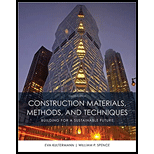
CONSTRUCTION MATERIALS,METHODS...-PKG
4th Edition
ISBN: 9781337495530
Author: SPENCE
Publisher: CENGAGE L
expand_more
expand_more
format_list_bulleted
Concept explainers
Question
Chapter 2, Problem 1RQ
To determine
The purpose of local zoning ordinances
Expert Solution & Answer
Answer to Problem 1RQ
Zoning ordinances regulate the degree of building development as per land use by grouping buildings into zoning districts.
Explanation of Solution
Local zoning ordinances are regulations which are used to regulate the degree of development according to land use. They promote health, safety, and general welfare of society. To separate incompatible uses and promote cohesive city planning, zoning ordinances group buildings together into zoning districts. The zoning districts include residential, commercial, business, and industrial zones. The ordinances set guidelines for area and height of building, density of population, and may also stipulate building styles.
Want to see more full solutions like this?
Subscribe now to access step-by-step solutions to millions of textbook problems written by subject matter experts!
Students have asked these similar questions
3. What types of subjects are covered by:
a) Zoning ordinances (6 Required)
b) Building codes (6 Required)
The typical categories of US Iocal zoning ordinances inclued A) R, C,I B) R, Z,IC) Z, C, P D) I,T, U
Explain each:
The two physical zoning concepts:
How these zoning concept can be apply in a simple residential house?
1. urban character
2. pedestrian accommodations
Chapter 2 Solutions
CONSTRUCTION MATERIALS,METHODS...-PKG
Knowledge Booster
Learn more about
Need a deep-dive on the concept behind this application? Look no further. Learn more about this topic, civil-engineering and related others by exploring similar questions and additional content below.Similar questions
- Factors for planning includearrow_forwardWhat are city planning and regional planning? Contrastplanning with zoning. Give examples of some of the suggestionsmade by early planners such as Edward Bennettin Portland.arrow_forwardExplain how the two functional and zoning concepts below will architect, engineer be able to use these concept in design process, especially in drafting initial schematic ideas for a specific projectarrow_forward
- How would you classify the two trip ends or zones in terms of landuse pattern and why?arrow_forwardDraw the setback and building area for a lot 130’ * 65’ according to the zoning requirements in your community. Determine the maximum size building possible for a site with 35% land coverage. Determine the maximum size of a house for that site.arrow_forward-Provide one of the functional and zoning concepts and explain it on how a engineer/architect will be able to use this concept in their design process, especially in drafting their initial schematic ideas for a specific project. -Draw the concept applying it in residential housearrow_forward
- Outline city and regional planning and land use strategiesarrow_forward7. which of the following is not a typical zoning constraint A. Anchor tenant lease restrictions B. green space requiremenrs C. fifty-foot front and thirty-foot side serbacks D. minumum vehicle parking requirementsarrow_forwardWhat are the different types of land use classification systems.arrow_forward
arrow_back_ios
SEE MORE QUESTIONS
arrow_forward_ios
Recommended textbooks for you
 Architectural Drafting and Design (MindTap Course...Civil EngineeringISBN:9781285165738Author:Alan Jefferis, David A. Madsen, David P. MadsenPublisher:Cengage Learning
Architectural Drafting and Design (MindTap Course...Civil EngineeringISBN:9781285165738Author:Alan Jefferis, David A. Madsen, David P. MadsenPublisher:Cengage Learning

Architectural Drafting and Design (MindTap Course...
Civil Engineering
ISBN:9781285165738
Author:Alan Jefferis, David A. Madsen, David P. Madsen
Publisher:Cengage Learning